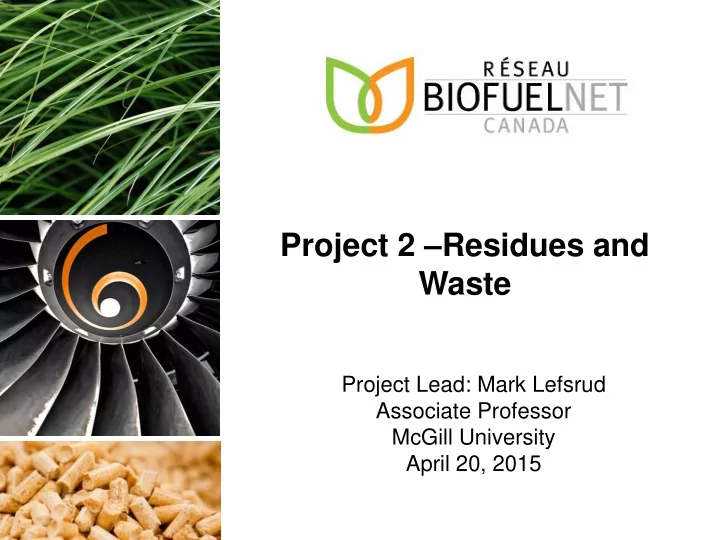

Project 2 – Residues and Waste Project Lead: Mark Lefsrud Associate Professor McGill University April 20, 2015
BioFuelNet: Residues and Waste • Management and collection of biological residues that include : – Municipal solid waste ( MSW ) – Agricultural residues (straw and stover) – Forestry residues (bark, sawdust, branches and other secondary feedstock from forestry including leaves) • Ability to integrate a decentralized approach for collection and management linking: – Depot system – Large central processing centers • Waste needs to be integrated into the value-added chain for biofuels and associated co-products which is very attractive for industrial implementation. 2
Advanced Biofuels Feedstock Source Agriculture residues Forestry residues Municipal waste 3
Abundant Biomass – Agriculture • 7% (68 million ha) of Canada’s land base is used for agriculture, an area about three times the size of Great Britain • In 2012, Canada produced – 77 Mt of grain (Canola, corn, wheat, etc.) – 20 Mt of straw – 35 Mt of forage production (animal grazing) – 30 Mt of MSW 4
Abundant Biomass – Agriculture 5
Project 2: Residues - Challenges o Biomass cost for biofuel purposes o Production Management : Biomass source, biomass yield and frequency of extraction, environment and soil conservation, and crop selection for improved residue yield. o Collection and Handling Management : Machinery for pre- processing, biomass size and volume reduction, source processing, and collection mechanisms. o Material sorting o Supply Management : Development of biomass depot and centralized systems, storage method and time, transportation methods, and supply modeling. o Quality and contamination characterization 6
Project at a glance Biomass residue depot: Preprocessing & Pre-treatment Biorefinery Depot Biomass 5 Research centers, 27 Investigators, 30 HQP, 28 Industrial Partners
Alignment strategy • Perform a technoeconomical analysis to Promote collaboration determine the cost per dry ton of single among, work packages biomass and blended feedstocks at End User and other projects, task utilization facility forces within and outside • Identify potential by-products (Animal BioFuelNet feed, bio composite, etc) that could improve biomass depot profits Process Shareholders Improvement • Develop the concept of a Develop a HQP training program • biomass depot system by Develop frameworks to define integrating operations such as quality standards for biomass and storage, preprocessing and pre- feedstock throughout each stage of Learning & treatment by defining the the supply chain • Growth technology that should be Perform product characterization of incorporated into the system multiple biomass residues and/or potential blending (Pellets)
Project 2 - Work Packages Ajay Dalai Lope Tabil Warren Mabee (University of (University of (Queen’s Saskatchewan) Saskatchewan) University) Processing and LCA and policy Waste canola treatment for for forestry cake to develop refuse derived products for water resistant fuel pellets liquid biofuels wood pellets Shahab Evelyne Sokhansanj Mark Lefsrud Thiffault (University of (McGill (Laval British University) University) Columbia) Acceptable Case study of Unloved wood contamination Mission BC residues levels in solid location (pellet) development biofuels
Project 2- Residues and Waste • Production Of Moisture-Resistant And Durable Fuel Pellets From Agricultural Wastes And Woody Biomass, And Their Gasification To Synthesis Gas – Ajay Dalai (University of Saskatchewan) – Agricultural and woody biomass, municipal solid waste (MSW), blended with canola meal . • Sorting, Processing And Densification Of Municipal And Agricultural Residue As Feedstock For Biofuel Production – Lope Tabil (University of Saskatchewan) – MSW , wheat and barley straw , and oat hulls • Biomass Residue Value Chain Quality And Contamination Characterization – Mark Lefsrud (McGill University) – Wood and fiber pellets with agricultural plastic and MSW • Assessing The Availability And The Potential Conversion Into Biofuels Of Unloved Woods : Creating An Interface With Traditional Wood Product Industries – Evelyne Thiffault (Laval University) • Feedstock Densification And Supply Management Incorporating Depots – Shahab Sohkhansanj (UBC) – Regular wood and torrefied pellets 10
Project 1- Purpose-grown Feedstock • Nutrient Cycling Dynamics In Poplar And Switchgrass Grown In The Pan-National Feedstock Sites At Guelph, Nappan, Kemptville And Edmonton. – Andrew Gordon (University of Guelph) • A Platform For The Production Of Biomass By Growing Willow On Contaminated Soils – Michel Labrecque (Université de Montréal) • Enhancing Production Of Purpose-Grown Biomass Feedstock Crops With The Use Of Plant-Growth- Promoting Organisms And Substances. – Kevin Vessey (Saint Mary's University) – Crops: Arundo donax and a cold-tolerant line of Miscanthus • Propagation And Distribution Of Miscanthus Rhizomes For Canadian Biofuel Production – Max Jones (University of Guelph) 11
Questions
Recommend
More recommend